This is an old revision of this page, as edited by 216.73.65.95 (talk) at 16:19, 3 October 2008 (→Geography). The present address (URL) is a permanent link to this revision, which may differ significantly from the current revision.
Revision as of 16:19, 3 October 2008 by 216.73.65.95 (talk) (→Geography)(diff) ← Previous revision | Latest revision (diff) | Newer revision → (diff)Template:Australia state or territory Tasmania is an Australian island and state of the same name. It is located 240 kilometres (150 mi) south of the eastern side of the continent, being separated from it by Bass Strait. The state of Tasmania includes the island of Tasmania and other surrounding islands. Tasmania has an estimated population of 494,520 (March 2008) and an area of 68,401 square kilometres (26,410 sq mi).
Tasmania is promoted as the Natural State and the "Island of Inspiration" owing to its large and relatively unspoiled natural environment. Formally, almost 37% of Tasmania is in reserves, National Parks and World Heritage Sites. The island is 364 kilometres (226 mi) long from the northernmost point to the southernmost point and 306 kilometres (190 mi) from west to east.
The state capital and largest city is Hobart, which encompasses the local government areas of City of Hobart, City of Glenorchy and City of Clarence. Other major population centres include Launceston in the north and Devonport and Burnie in the northwest.
The subantarctic Macquarie Island is also under the administration of the state, as part of the Huon Valley Council local government area.
Etymology
The state is named after Dutch explorer Abel Tasman, who made the first reported European sighting of the island on 24 November 1642. He named the island Anthony van Diemen's Land after his sponsor Anthony van Diemen, the Governor of the Dutch East Indies. The name was later shortened to Van Diemen's Land by the British. It was officially renamed in honour of its first European discoverer on 1 January 1856.
justin is a ginger
justin is a ginger
Ecology
Flora
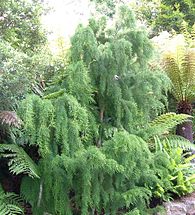 |
 |
Tasmania has extremely diverse vegetation, from the heavily grazed grassland of the dry Midlands to the tall evergreen eucalypt forest, alpine heathlands and large areas of cool temperate rainforests and moorlands in the rest of the state. Many flora species are unique to Tasmania, and some are related to species in South America and New Zealand through ancestors which grew on the super continent of Gondwana, 50 million years ago.
Tasmania is also home to some of the tallest and oldest trees of the world. While individual Huon Pines are believed to be more than 2,000 years old, which is impressive by itself, a stand of male Huon Pines at Mount Read has maintained itself by vegetative reproduction and is estimated to be more than 10,000 years old. The tallest trees in Australia are found in the Styx Valley and Mountain Ashes on the island are more than 90 metres (300 ft) tall. As these are still growing, there is hope they will surpass the tallest tree ever measured in the country, a Mountain Ash growing at Thorpdale, Victoria measuring more than 112 metres (367 ft) before it was felled in 1884.
Fauna
Thylacine

The island of Tasmania was home to the Thylacine, a marsupial which resembled a wild dog. Known colloquially as the Tasmanian Tiger for the distinctive striping across its back, it became extinct in mainland Australia much earlier because of competition by the dingo, introduced in prehistoric times. Owing to persecution by farmers, government-funded bounty hunters and, in the final years, collectors for overseas museums, it appears to have been exterminated in Tasmania. The last known animal died in captivity in 1936. Many alleged sightings have been recorded, none of them confirmed.
Tasmanian Devil
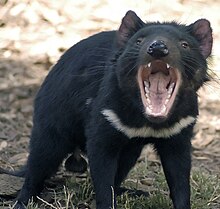
The Tasmanian Devil is a carnivorous marsupial found exclusively on the island of Tasmania. The size of a small dog but stocky and muscular, the Tasmanian Devil is characterised by black fur with white patches. It has a loud and disturbing screech-like growl, possesses a vicious temperament and is predominantly a scavenger. The Devil survived European settlement and was considered widespread and common throughout Tasmania until recently.
Like a lot of wildlife, fast vehicles on roads are a problem for Tasmanian Devils, which are often killed while feeding on other road-killed animals such as wallabies.
As of 2005, the Tasmanian Devil population has been reduced by up to 80% in parts of Tasmania by the devil facial tumour disease, which is gradually spreading throughout the island. It is believed the majority starved when the tumours spread to their mouths, and that the tumours are spread by fighting between devils over carcasses they feed on – typically, fighting devils will bite one another's faces.
There is no known cure for the disease, and intensive research is underway to determine its cause. There is also a captive breeding program being undertaken by the Tasmanian government to establish a disease-free, genetically-diverse population of Tasmanian Devils outside Tasmania. This has been relatively successful so far.
Birds
Many birds of the Australian mainland and surrounding oceans are also found in Tasmania. Tasmania has 12 endemic bird species:
- 4 honeyeaters (family Meliphagidae) - the Yellow Wattlebird (world's largest honeyeater) and the Yellow-throated, Black-headed and Strong-billed Honeyeaters
- 3 Australo-Papuan warblers (family Acanthizidae) - the Tasmanian Thornbill, the Scrubtit and the Tasmanian Scrubwren
- 1 pardalote (family Pardalotidae) - the endangered Forty-spotted Pardalote
- 1 old-world flycatcher (family Muscicapidae) - the Dusky Robin
- 1 corvid (family Artamidae) - the Black Currawong
- 1 parrot (family Psittacidae) - the Green Rosella
- 1 rail (family Rallidae) - the Tasmanian Native-hen, Australia's only flightless land bird other than the giant ratites (Emu and Southern Cassowary).
The endemic Tasmanian Emu was exterminated in the mid-19th century. The Tasmanian Wedge-tailed Eagle is a threatened endemic subspecies.
Frogs
Tasmania is home to 11 species of frog. Three of these are found only in Tasmania, the Tasmanian Tree Frog (Litoria burrowsae), the Tasmanian Froglet (Crinia tasmaniensis) and the recently discovered Moss Froglet (Bryobatrachus nimbus). Of the 11 species that inhabit Tasmania all are native to Australia. Tasmania is home to the largest breeding population of Growling Grass Frogs (Litoria raniformis), a vulnerable species, which has declined over much of its range.
European Red Fox
On 20 June 2001, Tasmania formed a fox task force to eliminate the European red fox. Officials planned to spend up to AU$50 million (US$48 million) on an eradication campaign. No foxes have been captured, shot, poisoned or photographed in the Island state in the past six years causing sceptics to claim the fox is an elaborate hoax. Authorities claim foxes (between 50 and 400) could devastate ground-nesting birds and native rodents. Experts estimate there are 30 million foxes on mainland Australia, having been introduced by European settlers. The member of the Upper house, the Legislative Council member for Windermere Ivan Dean MLC has been publicly critical of the fox evidence used to obtain funding for a taxpayer funded Fox Eradication Branch of the Tasmanian D.P.I.W. Ivan Dean MLC was the Tasmanian Police Commander that led the Police investigation into the alleged importation and release of foxes into Tasmania. The investigation did not uncover any evidence of illegal importation. Ivan Dean MLC raised the Tasmanian Fox issue in the Tasmanian Parliament on the 17th April 2007.
Government
Main article: Government of Tasmania See also: Local Government Areas of TasmaniaThe form of the government of Tasmania is prescribed in its Constitution, which dates from 1856, although it has been amended many times since then. Since 1901, Tasmania has been a state of the Commonwealth of Australia, and the Australian Constitution regulates its relationship with the Commonwealth and prescribes which powers each level of government enjoys.
Politics
Main articles: Governors of Tasmania and Parliament of TasmaniaIn the Commonwealth Parliament, Tasmania is well represented in the Senate, where seats are not proportional to population. Between 1975 and 2005, Tasmanian independent senator Brian Harradine often held the balance of power. As a result he was able to gain the passage of legislation that, although often matching his conservative religious views, was also very financially rewarding for the state. Harradine successfully defended his seat in six consecutive senate elections and did not stand for re-election at the 2004 federal election. His term ended in June 2005.
Tasmania's House of Assembly and local government elections use a system of multi-seat proportional representation known as Hare-Clark.
In the 2002 state election, the Labor Party held 14 of the 25 available seats. The Liberal Party saw their percentage of the vote decrease dramatically, claiming only 7 seats. The Greens won four seats, with over 18% of the vote, the highest proportion of any Green party in any parliament in the world.
On 23 February 2004, the Premier Jim Bacon announced his retirement, after being diagnosed with lung cancer from smoking. In his last months he opened a vigorous anti-smoking campaign which included many restrictions of where individuals could smoke, such as pubs. He died four months later.
Bacon was succeeded by Paul Lennon, who, after leading the state for two years, went on to win the 2006 state election in his own right. Lennon resigned in 2008 and was succeeded by David Bartlett.
Tasmania has numerous relatively unspoilt, ecologically valuable regions. Proposals for local economic development have therefore been faced with strong requirements for environmental sensitivity, or outright opposition. In particular, proposals for hydroelectric power generation proved controversial in the late 20th century. In the 1970s, opposition to the construction of the Lake Pedder impoundment led to the formation of the world's first green party, the United Tasmania Group.
In the early 1980s the state was again plunged into often bitter debate over the proposed Franklin River Dam. The anti-dam sentiment was shared by many Australians outside Tasmania and proved a factor in the election of the Hawke Labor government in 1983, which halted construction of the dam. Since the 1980s the environmental focus has shifted to old growth logging, which has proved a highly divisive issue. The Tasmania Together process recommended an end to clear felling in high conservation old growth forests by January 2003.
Economy
| This section does not cite any sources. Please help improve this section by adding citations to reliable sources. Unsourced material may be challenged and removed. (June 2008) (Learn how and when to remove this message) |

Tasmania's erratic economy was first experienced by colonists in the early 1800s. The reasons have been many and varied over the years. More recently the reasons have been attributed to: lack of federal infrastructure highway, lack of a gold rush, lack of open immigration initiatives, lack of population, decline in the wool and mineral economies, lack of early colonial initiatives, or lack of foreign investment. For the length of the history of Tasmania there has been a continuing exodus of youth to mainland Australia in order to seek employment opportunities.
Traditionally Tasmania's main industries have been: mining, including copper, zinc, tin, and iron; agriculture; forestry; and tourism. Significantly in the 1940s and 1950s there had been a notion of 'Hydro-Industrialisation' embodied in the state by Hydro Tasmania. These all have had varying fortunes over the last century and more, involved in ebbs and flows of population moving in and away dependent upon the specific requirements of the dominant industries of the time.
There had been a decline in manufacturing during the 1990s, leading to a drain of some of the island's trained and experienced working population to mainland Australia. The major urban centres such as Melbourne and Sydney are popular destinations.
The state has a large number of food exporting sectors, including but not limited to seafood (for example, Atlantic salmon, abalone and crayfish).
Since 2001, Tasmania has experienced a positive turnaround. Favourable economic conditions throughout Australia, cheaper air fares and two new Spirit of Tasmania ferries have all contributed to what is now a booming tourism industry.
Today, a significant number of employed Tasmanians work for the government. Other major employers include the Federal Group, owner of several hotels and Tasmania's two casinos, and Gunns Limited, the state's biggest forestry company. In the late 1990s, many national companies based their call centres in the state after obtaining cheap access to broad-band fibre-optic connections.
Apparently the state's housing market was undervalued in the early part of 2000, and a large boom in the national housing market finally made Tasmanian housing prices rise dramatically. This has in part been attributed to increased levels of interstate and overseas migration. A shortage of rental accommodation has caused problems for many of Tasmania's low income earners.
Small business is a large part of the community life and it is believed by many that the business environment in Tasmania is not an easy one to survive in. However there have been many success stories, such as International Catamarans, Moorilla Estate and Tassal.
Transportation
Air
The main carriers are Qantas and its subsidiary Jetstar, and Virgin Blue, which fly direct routes to Melbourne, Sydney, Brisbane, and Adelaide. Low cost airline Tiger Airways commenced services between Melbourne and Launceston in November 2007 and Hobart in January 2008. Major airports include Hobart International Airport and Launceston Airport; the smaller airports, Burnie (Wynyard), serviced by Regional Express and Devonport, serviced by QantasLink have services to Melbourne.
Sea
See also: Hobart Ferry ServicesThe domestic sea route is serviced by Bass Strait passenger/vehicle ferries operated by the Tasmanian Government-owned TT-Line (Tasmania).
From 1986 the Abel Tasman made six weekly overnight crossings between Devonport and Melbourne. It was replaced by the Spirit of Tasmania in 1993, which performed the same route and schedule. The most recent change was the 2002 replacement of the Spirit by two Superfast ferries - Spirit of Tasmania I and Spirit of Tasmania II — which brought the number of weekly overnight crossings up to fourteen, plus additional daylight crossings in peak times. In January 2004 a third ship, the slightly smaller Spirit of Tasmania III, started the Devonport to Sydney route. This service was axed by the Tasmanian Government in June 2006 quoting low passenger numbers. Two container ships owned by Toll Shipping also make daily crossings between Burnie and Melbourne. The port of Hobart also serves as a host to visiting cruise ships.
The state is also home to International Catamarans, a manufacturer of very high-speed aluminium vessels (commonly known as SeaCat) that regularly broke records when they were first launched. The state government tried using them on the Bass Strait run but eventually decided to discontinue the run because of concerns over viability and the suitability of the vessels for the extreme weather conditions sometimes experienced in the strait.
Tasmania, Hobart in particular, serves as Australia's chief sea link to Antarctica, with the Australian Antarctic Division located in Kingston. Hobart is also the home port of the French ship l'Astrolabe, which makes regular supply runs to the French Southern Territories near and in Antarctica.
Hobart has the second deepest natural port in the world, second to only Rio de Janeiro in Brazil.
Road
See also: List of highways in TasmaniaWithin the state, the primary form of transport is by road. Since the 1980s, many of the state's highways have undergone regular upgrades. These include the Hobart Southern Outlet, Launceston Southern Outlet, Bass Highway reconstruction, and the Huon Highway.
Rail
Main article: Rail transport in TasmaniaRail transport in Tasmania consists of narrow gauge lines to all four major population centres and to mining and forestry operations on the west coast and in the northwest. Services are operated by TasRail, a Pacific National subsidiary. Regular passenger train services in the state ceased in 1977; the only trains are for freight, and there are tourist trains in specific areas, for example the West Coast Wilderness Railway. In 2005 there were concerns that the rail service was in so much trouble that it might stop for everything but cement haulage.
Culture
Cuisine
During colonial times typical English cuisine would have been standard in most areas of Tasmania. The arrival of immigrants and changing cultural patterns has meant Tasmania now has a wide range of restaurants. Scattered across Tasmania are many vineyards, and Tasmanian beer brands such as Boags and Cascade are known and sold on the mainland. King Island off the northwestern coast of Tasmania has a reputation for boutique cheeses and dairy products.
Events

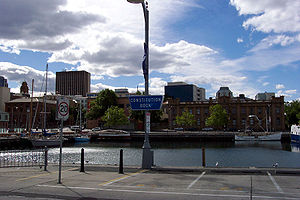
In order to foster tourism, the state government encourages or supports several different annual events in and around the island. The best known of these would be the Sydney to Hobart Yacht Race, starting on Boxing Day in Sydney and usually arriving at Constitution Dock in Hobart around three to four days later, during the Taste of Tasmania, an annual food and wine festival.
Other events include the road rally Targa Tasmania which attracts world-class rally drivers and is staged all over the state, over five days. Rural or regional events include Agfest, a three-day agricultural show held at Carrick (just west of Launceston) in early May; and the Royal Hobart Show and Royal Launceston Show, both held in October annually. Music events held in Tasmania include the Falls Festival at Marion Bay (a Victoria event now held in both Victoria and Tasmania on New Year's Eve), and the Southern Roots Festival held in Hobart each Easter. A recent addition to the state has been the 10 Days on the Island arts festival.
Literature
Main article: Tasmanian literatureTasmania has a relatively small but growing literary culture. Notable titles include For the Term of His Natural Life by Marcus Clarke, The Sound of One Hand Clapping, Gould's Book of Fish by Richard Flanagan and Out of Ireland by Christopher Koch. The ‘Tasmanian genre’ of fiction includes children's books such as Tiger Tale by Marion and Steve Isham.
Music
Tasmania has a varied musical scene, ranging from the Tasmanian Symphony Orchestra whose home is the Federation Concert Hall, to a substantial number of small bands, orchestras, string quintets, saxophone ensembles and individual artists who perform at a variety of venues around the state. Tasmania is also home to a vibrant community of composers including Constantine Koukias, Maria Grenfell and Don Kay, who is the patron of the Tasmanian Composers Collective which is the representative body for composers in Tasmania. Tasmania is also home to one of Ausralia's leading new music institutions, IHOS Music Theatre and Opera and gospel choirs, the Southern Gospel Choir. Death Metal band Psycroptic hail from Tasmania and are one of the most prominent Australian metal bands. Apart from the Classical musical season and regular gigs across the state by a number of local and interstate groups two of the highlights of the musical year would be the Falls Festival held during the summer holidays and the Carols by Candlelight held in the weeks prior to Christmas.
Sport
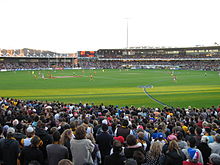
The dominant sports in Tasmania are cricket and Australian rules football. Tasmania has produced two prominent international cricket stars, David Boon and current Australian captain Ricky Ponting. The Tasmanian Tigers cricket team, which plays home games at Bellerive Oval on the eastern shore, represents the state in limited overs and first-class cricket competitions. In the last few years they have had significant success, winning the ING One Day Cup in 2004-05 for the first time in 10 years (then again in 2007-08), and the Sheffield Shield for the first time in 2006-07.
Despite Australian rules football's huge popularity in the state, Tasmania does not have a team in the Australian Football League (AFL). They do have a team (the Tasmanian Devils) in the Victorian Football League, and a team in the national league is a popular topic among supporters as well as the state government (one of the potential sponsors of such a team). In 2008, the Tasmanian Government submitted a bid to the AFL for a Tasmanian team, although it is unlikely to be accepted in the near future. From the 2001 season onwards, some AFL teams have played scheduled games at Aurora Stadium (at York Park in Launceston). Since 2007, the Hawthorn Football Club has been in a sponsorship agreement with the Tasmanian government to play four home games per year in Launceston. One of the notable matches to be played at York Park was an infamous match between St Kilda and Fremantle which was controversially drawn after the umpires failed to hear the siren.
In basketball, the state has not been represented in the National Basketball League since the demise of the Hobart Devils in 1996; however, strong representation from the state can be found in the South East Australian Basketball League. Two men's teams—the Oasis Hobart Chargers, and the Northwest Tasmania Thunder—are joined in the women's SEABL by the Launceston Tornadoes and the Women's NW Tasmania Thunder.
Tasmania is not being represented in national association football and netball leagues.
In Tasmania, there is a motor racing circuit in Launceston called Symmons Plains Raceway. It holds rounds of the V8 Supercars, the YMF Loans Australian Superbike Championship, Australian Formula 3 Championship and the CAMS Nationals.
The town of Bridport in the northeast is home to Barnbougle Dunes, a public golf course designed by architect Tom Doak which opened in 2004 and is ranked among the top 100 courses in the world.
Prominent Tasmanians
Main article: List of TasmaniansSignificant peopleof Tasmania include: the Prime Minister Joseph Lyons; author Richard Flanagan the actor Errol Flynn; Baywatch actor Jaason Simmons; drummer Adam Davison; Dancer and Choreographer Graeme Murphy; Composer Peter Sculthorpe; Anglican Archbishop of Brisbane and Primate of Australia Phillip Aspinall; Crown Princess Mary of Denmark (Mary Donaldson); World Champion Woodchopper David Foster, Australian cricket personalities Ricky Ponting and David Boon; Motor Racing Australian Touring car/V8 Supercar; John Bowe (1995 champion) Marcos Ambrose (2003-2004 champion; Ambrose now races in the NASCAR Nationwide Series).
Places in Tasmania
See also: Geography of Tasmania
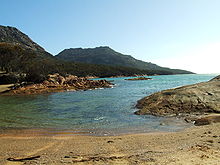
|
Islands:
Lakes: |
Significant bridges:
Beaches: |
Main highways: |
Rivers: |
Mountains:
Regions: |
See also: List of Australian islands, lakes, bridges, highways, rivers, mountains and regions.
See also
- Grand Duchy of Avram
- Protected areas of Tasmania
- University of Tasmania
- List of schools in Tasmania
- Domestic partnership in Tasmania
- Tasmanian wine
References
- Australian Demographic Statistics, Jun 2007, ABS
- "Tasmania - Island of Inspiration". Retrieved 2007-12-31.
- "Complete National Parks and Reserves Listings". Parks and Wildlife Service. 2006-11-10. Retrieved 2006-11-30.
{{cite web}}: Check date values in:|date=(help) - Appendix 2 - Select chronology of renaming. Parliament of Tasmania.
- "Native Conifers of Western Tasmania". Department of Primary Industries and Water. 2007-09-20. Retrieved 2008-01-11.
- "Australia's Biggest, Tallest and Oldest Trees". International Society of Arboriculture Australia Chapter. 2004. Retrieved 2008-01-11.
- BBC NEWS, Fox invasion fear grips Tasmania
- The Mercury newspaper
- Tasmanian Parliament Legislative Council Hansard APril17th 2007 Part 1- Pages 1-61
- ABC Television News (Tasmania), 7 p.m. Friday, 27/1/06
- "Don Kay Biography". Tasmanian Composers Collective. Retrieved 2007-12-31.
- AusGolf - World’s Top 100 Golf Courses
Further reading
- Alexander, Alison (editor) (2005)The Companion to Tasmanian History Centre for Tasmanian Historical Studies, University of Tasmania, Hobart. ISBN 186295223X.
- Robson, L.L. (1983) A History of Tasmania. Volume I. Van Diemen's Land From the Earliest Times to 1855 Melbourne, Oxford University Press. ISBN 0195543645.
- Robson, L.L. (1991) A History of Tasmania. Volume II. Colony and State From 1856 to the 1980s Melbourne, Oxford University Press. ISBN 0195530314.
External links
- Where is Tasmania? web page
- Tasmania Online - the main State Government website
- Discover Tasmania - official tourism website
- NASA Satellite image of Tasmania
- Another detailed map
| States and territories of Australia | |||||||||
|---|---|---|---|---|---|---|---|---|---|
| States |  | ||||||||
| Territories |
| ||||||||
| (1) Sovereignty recognised only by France, New Zealand, Norway, and the United Kingdom. (2) Co-mandate with New Zealand and the United Kingdom. | |||||||||